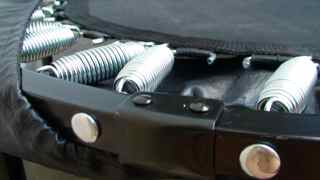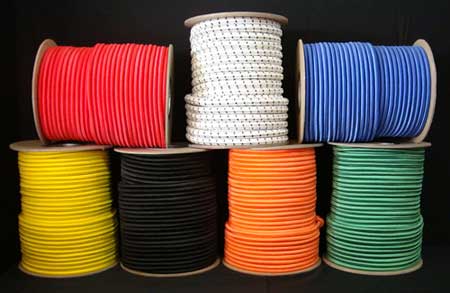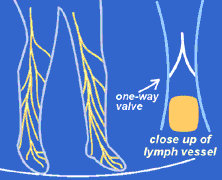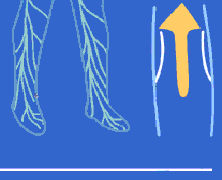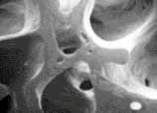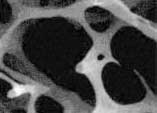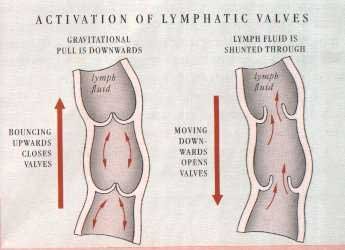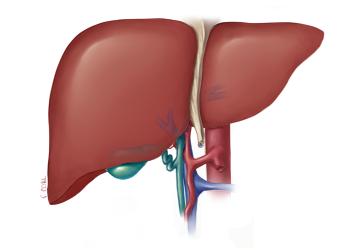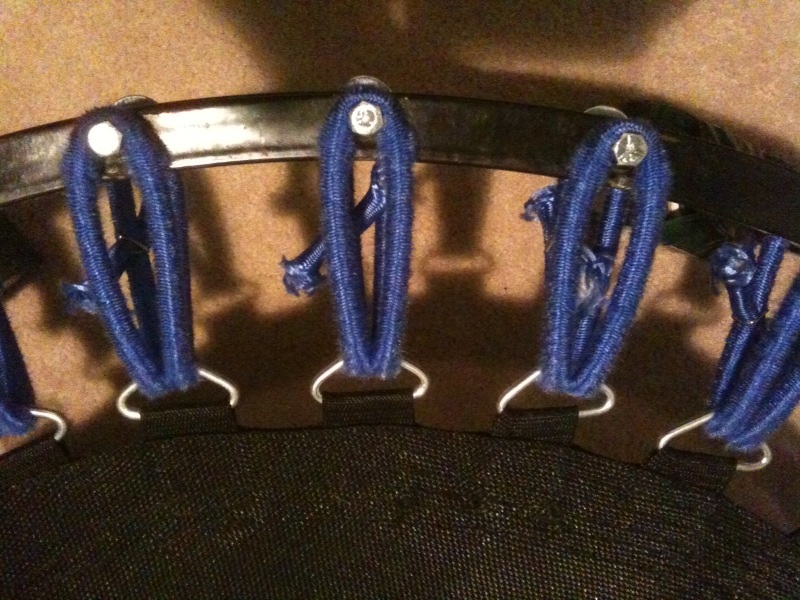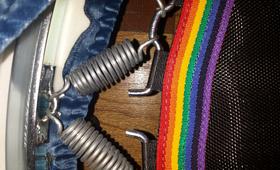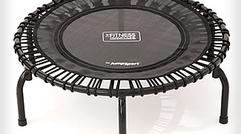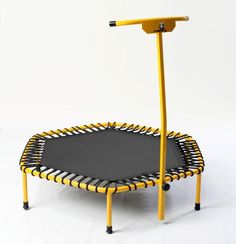I finally can do the Health Bounce. I couldn't do it even if I wanted to on my first rebounder. It was too soft
and I could not get 3 G forces unless I jumped out of the mat.
Neither spring rebounders nor bungee rebounders are better than the other. The best rebounder is the one that is best for YOU. This page will help you decide which one is best for you without listening to someone say one is better than the other.
Because lymphatic flow becomes more active while rebounding, the rate of lymphatic flow can become as high as 15 times. Some rebounders give less than 3 G force and some give more than 3 G force. Giving more G force can work against the goal of flushing lymph as too much force can cause the one way valves that pump away from gravity to shut longer. Closing the valves too long disrupts the flow in the valves. A rebounder that is too soft can still move lymph but with less G force the less of a factor the lymph flow can be raised.
Remember, the valves shut at the exact point when you go away from gravity. If too much of a constant force, then the valves can hold too long with not enough time to let in nutrients and eliminate the wastes. The goal is to dissolve and dislodge the waste and have enough time to replenish with cleaner lymph. The reason many people feel better after rebounding is because all the excess blood proteins and toxins get released and fresh lymph is replaced.
A good rebounder gives more G forces, not too few so that it doesn't activate the flaps in the one way valves properly nor too hard to cause them to shut too long. The more of these flushes you get per minute at 3 G forces the more the wastes in the lymph can flow.
Although some rebounders will still move lymph, they can move lymph at the rate of 4x, 8x, 10x or as high as 15x. There are signals when you are going at the rate of 15x and also signals that you are moving lymph at a slower rate.
Again, you don't want too few bounces per minute nor too many bounces per minute so that there is in not enough time to flush out the wastes.
When the body is suspended in the air during the bounce, weightless, and the pressure in the body is at it's lowest, this is when the nutrients from the body go into the cells. If there is not enough G force or pressure during the bottom of the bounce, not enough waste can be squeezed out and therefore no nutrients can be replaced due to no room.
A quick note about using the bar:
While bouncing on a rebounder many people will want to use the bar so they can balance themselves when doing leg kicks and curls and and side way leg motions. By strengthening and building the leg muscles it can act as the auxiliary pump for the body's cardiovascular system. This can help put less strain on the heart. Most of the lymph is pumped by the legs.
Bottom of Bounce
Valves Closed
Top of Bounce
Valves fully opened
As you read this, keep in mind how a bungee and a spring's responsiveness differ. Just like each type of spring responds differently to different weights, so does bungees. Some bungees are a one size fits all and some can be adjusted to the body weight of the person to give the perfect rhythmic Health Bounce. I do not suggest people to have to depend on bouncing near the edges of rebounders because the center is too soft. By getting the right tension of a spring or the right length and strength of bungee cord can make a major difference in the bounce. Having too much air time or having to use too much energy to get a bounce can prevent the G forces needed to get the Health Bounce. If you can bounce while barely coming off the mat by doing landing on your heels to absorb the Force and then rolling to the toes then you got a good rebounder.
Many rebounders are too soft and too firm and you have to land on your toes first to avoid the pressure against the knees. Very firm rebounders are painful to do the heel to toe bounce. Rebounders that are too soft might cause you to use more of your leg muscles or arms to get a enough bounce which interferes with absorbing the G force.
Look back at the pictures above. Notice how when you are at the bottom of your bounce, the G force are the greatest. This is when the flapper valves open and shut. This is the time when the toxins are flushed out because when the flaps are closed, there is no where for it to store but out of the cell. Notice on the next picture as the body starts to rise from the bottom of the bounce, the valves are still closed and the wastes come out of the cells, the vitamins and minerals we get in our diet are pushed back into the cells.
When the body is finally suspended (but not weightless yet) in the air after the G force goes from 3Gs to 2Gs to 1Gs to finally weightlessness, the valves open. (this is probably the time to come up with your own opinion if a bungee gives you more time to flush the toxins and replenish due to a more constant force and more time in the air to allow the transition of wastes out and nutrients in, but with less bounces per minute, or a spring rebounder that gives a shorter G force and less constant force on the body with more bounces per minute.
So, at the top peak of the bounce when the body has zero G forces upon it, the valves are open. This is when the valves are fully open, not partially closed. At that point, the body starts to descend and this is when the nutrient fluids flow into the cells. The whole goal of rebounding repetitively is to literally suck these toxins and wastes from the cells and finally eliminate them through the lymphatic system.
At the height of the bounce the body is weightless, and the valves are open. As the body descends, fluid flows. Toxins are sucked out and away from the cells, then eliminated by the lymph system. As the lymphatic system becomes less sluggish and the the thick toxic fluids get replaced by clean lymph, the body hopefully will start functioning like it should.
Good bone density Poor bone density
When choosing a spring or bungee rebounder, thinks about which type will build bone mass the best. Bones, as we know, like muscle, can become stronger and even more dense from moderate to heavy physical stress.
More G forces upon the bones are shown to make bones have a higher mineral content. Many people have osteoporosis that call me that worry about fracturing their bones while rebounder. The funny thing is, bone clinics that I have talked to encourage rebounding to prevent fracturing. Does a bungee or a spring rebounder build better bone density? That depends on the current state of someone's bones. If the bones are so low in bone density that even walking hurts that can help us choose which type to get. What we don't want is a rebounder that is too jarring but also not a rebounder that removes all the ballistic impact so that there is not enough G force.
Many people pick out a bungee for certain reasons over a spring rebounder, and vice versa. Some people want to use a rebounder for jogging while others want one that gives deep bounces for building muscle while using weights. Some people want to build bone density but most people want to use the rebounder to flush lymph. Whatever the case, the rebounder has to be balanced with your weight so you don't jar yourself nor get too much air time or any other factors that prevent doing the Health Bounce. Regardless if you are bouncing to move lymph, if you can't do the Health Bounce and get at least 3 forces, then I strongly doubt the rebounder is for you. (I will have a check list soon for you to use so that when you buy your rebounder you can see how many checks are in the rebounders favor. If not, then you should know).
A balanced rebounder will vary the cellular pressure by opening and closing the one way valves. You get enough bounce even WITHOUT LEAVING THE MAT to make enough G force at the bottom of the bounce to shut the valves and enough time in the air to decrease pressure so the one way valves open back up. Each bounce pumps the lymph fluid. When choosing a bungee or spring based rebounder, imagine which one will work best with your body type to give you enough bounce. If you are very light weight you might not have enough force to create 3 g forces on certain rebounders just as if someone is very heavy they will sag or invert the mat or cone in the mat and they will have to use excess force to give 3 G forces as the spring or bungee might not be responsive enough. I will NEVER use my muscles to create enough force due to a lack of responsiveness of a spring or bungee.
Just because you are rebounding or sweating on a rebounder doesn't mean you are getting the results that rebounding offers. Some people have been rebounding for years and are still overweight and still have the problems they had the day they bought it. Others call me up and tell me how rebounding helped. Two people can buy the same rebounder and one gets benefits and the other person doesn't. They call me up and I ask how they bounce and they tell me how they are bouncing. People are either bouncing too high, landing on their toes first and all sorts of wrong ways to bounce and this is why some people bounce for years without seeing results. By landing on your toes instead of your heels, you can get lower than 2 G forces when if you are bouncing on your heels you can get 3 G forces.
A balanced rebounder will give around 90 to about 120 bounces per minute. At the low end, a balanced rebounder will give the body 3 G forces 5,400 times up to 7,200 times. That is up to 7,200 jumps in one hour.
If doing exercises such as arm or leg curls this an add up to a lot of repetitions.
Note from me: It is not my job to tell someone that they should get a bungee or a spring based rebounder when they call me. I will find out what the person wants and based this on their current state of health and give my opinion on which rebounder I would recommend. I can get almost all of the brands and although opinionated, I do not impose my opinions on others' choices without understanding someone's needs first.
I have had to take down many of my videos due to my opinions that I cannot express publicly. As you can see in the intro video on my home page, this site goes to every extreme to find out if the claims of the manufacturers match the rebounders.
I have taken my rebounders to the parks, have had people with back problems, knee problems, ankle problems and every other kind of problem you can imagine bounce on the different rebounders. Since 2004, after owning just about every rebounder and finding which ones work better with certain body types, I feel that I have enough experience with the different types of rebounders that I can give opinionated answers to peoples' questions without feeling like I am making stuff up. I welcome people to pick my brain about rebounding.
It can take very little time to get rid of the excess fat, fibrin, excess blood proteins, globulin, and mucous that is in a sluggish lymphatic system.The rebounder that give the most rhythmic Health Bounce (barely coming off the mat) regardless of the person's weight without inverting the ankles is the rebounder that is optimal for most people.
Still can't decide over a bungee and a spring rebounder?
First, bungees give more bounce and higher tension springs allow for less bounce but way way way more G force per bounce than lower tension springs or bungees. There are companies that make lower tension springs that give a very softening bounce with lesser G force and those that have firmer springs but give too much G force which creates too much ballistic impact and it can hurt your knees and ankles.
Each rebounder company makes springs that each have a different tensile strength. Their are some springs that are triple tiered that have a lower tensile strength in the belly of the spring and then another tensile strength next to it and even a third tensile strength on the ends. This is the latest in the rebounding evolution. Now they even coat them with lower melting point alloys so they can absorb heat so they won't have to be replaced as they won't weaken like different types of springs.
The bungee gives a high bounce and absorbs most of the impact as it brings you to a halt at the bottom of the bounce. The G force is weakened but it gives a very high bounce. This is the opposite of what the promoters of the lymphatic Health Bounce are trying to do. The spring rebounders give more of a flatter surface as the some of the bungees might cone in as the mat gives. If you are going to get a bungee, I suggest getting the smallest mat to avoid pronation but the G force is what we want. If you are a jogger and never going to to bounce with both feet doing the Health Bounce, the bungee is fine. But for lymphatic drainage that I do, I can't see it done in the time it takes on a high quality heavy gauge spring model that keeps you closer to the mat.
If you are going to get a bungee, the ones that have around a 33 inch skirt will not invert your ankles like the bigger mats. If you plan on bouncing high you might need better cords but if you are trying to get close to the Health Bounce, you might want to get the highest tensile strength bungee cord on a bungee. I rarely see people buying the softer ones.
Contact me if you want help picking out a bungee that will fit your needs.
It's Time To Choose:
Spring or Bungee!
Before deciding on a bungee or a spring rebounder, know that you do not need shoes if using a spring based rebounder as they rarely cone in. You can try wearing running shoes made for pronation and that will help if using a larger mat or a rebounder that cones in.
When deciding on a spring or bungee model, know that each type has a different G force upon the body, typically from zero G forces at the top to 2 to 3 G forces at the bottom. The goal of when I look for a lymphatic rebounder is to get as close as 3 G forces as possible without leaving my feet from the mat, opposite of what a very springy rebounder does. Some rebounder mats tend to throw you to 3 G forces and others tend to "bump" you to 3 G forces. Knowing if you are doing more lymphatic bouncing rather than mainly aerobic exercise such as jogger rebounders where they are good for running in place, this will help decide over a bungee or a spring based rebounder.
It is possible to move lymph without doing the Health Bounce where you do not come off the mat but instead jumping high using your legs or arms to propel you, but this is only somewhat effective in activating the hydraulic pump to move lymph. The best way is to let the muscles squeeze the lymphatic vessels and also at the same time using gravitational forces to create a pump as well. I have noticed that the more bounces I get per minute during a bounce session the more smelly my sweat is and the more lighter I feel when I get off the rebounder. I feel more of the flush.
As part of my daily routine I jump on the rebounder just after I wake up. It gets my day started without really working out but just doing tiny bounces which requires hardly any energy. After being stagnant all night, I appreciate the rebounder to start moving the wastes out. I try to also do deep breathing while bouncing as this is another way to move lymph too.
A rebounder that guarantees the Health Bounce will be the one that moves the wastes out of the cells and lets the nutrients come back in at the top of the bounce. If there is too much time in between the bounces it is a waste of time unless you are doing fitness exercises. The more times the lymph is recycled in a session the quicker the wastes can leave the body.
The spring rebounders are the best way to get the Health Bounce.
Many people are so out of shape that the health bounce gets rid of the toxins so that in the future they can start doing more cardiovascular exercises. With a sluggish lymphatic system it is very hard to have good cardio strength in the first place. Many people are taught to just jump but the right way to do it is to keep the feet together, not spaced a part.
Again, people forget this.. so I will repeat.. do not space your feet apart.
The problem is that on some rebounders it will cone in in you keep your feet very close together. And most people start spacing their feet more apart and jump sort of with their feet at an angle. It should be direct up and down G forces, not G forces applied to your legs at an angle. This is why people complain and return rebounders that cone in even if they do give the Health Bounce. If you try jumping with your feet spaced apart you will feel it differently in your ankles and knees instead of if you jump with your feet close together. Try jumping for a few minutes with your legs far away and your ankles inverted in this way and you will feel what it feels like to have your ankles invert.
To get 3 G forces should not require you to raise your heart rate or start breathing heavily. My lymphatic system is flushing all day as I talk on the phone with people and people never know I am bouncing as I never start breathing hard. Again, my toes nor my heals never leave the mat.
I am also calling gyms to try to get them to put rebounders in their gyms so people can eliminate lactic acid pools in their muscles by bouncing after hard weightlifting workouts.
I actually have brought my tri fold rebounder with me with all my workout clothes in the case (yes, I use it as my gym bag, my tri fold carrying case) and have been told I cannot bring my own equipment in as its an insurance risk if the club does not own the equipment. So, unless I am told I can't bring it to a gym, as some gyms don't care, I bring it in the steam room and bounce. All the men usually leave the room as they think its weird me bouncing without any clothes on. I'm doing dry skin brushing, deep belly breathing, so I guess it would offend some people but even more offensive is how bad the dry sauna smells after toxic people are sweating like pigs.
Another thing you want to look for is a rebounder that will give you higher bounces if you use your muscles to lift off. High quality spring models and bungees can do this.
On a triple tiered spring, the 2nd and 3rd tier engage if you aren't doing the Health Bounce and you can go pretty darn high in them. A toning bounce, opposite of a Health Bounce, is when you use both feet and leave the mat all at once, (not jogging where you have one foot go up and one foot down, which you can do on almost any rebounder). This gives a higher than 3 G forces and strengthens the body and the cells but be careful because this can screw up springs which you will have to replace them if they stretch as you won't get a good Health Bounce but if you aren't doing the Health Bounce, the springs should last about 2 years with jumping off the mat type bouncing. A bungee rebounder, unless it has a heavy tensile strength, should last not as long as the springs but longer if they are high quality cords and can fit your body weight. Newer bungee models have cord settings which is really neat now.
The last type of bounce is the Cardio Bounce.
This is when you jump in the sweet spot of the rebounder where you cannot be thrown off by a firmer edge and a softer center.
This is jogging in place where you get your knees up as high as you can while always keeping one foot on the mat. It is always good to do some Health Bouncing with both feet before doing this as to warm up. Better rebounders can help keep your legs from locking while you are running in place. With a better rebounder I can run in place as fast as you can without worrying about keeping my knees too bent so they don't accidentally leg-lock. If you are wanting to do the Health Bounce as well as use the rebounder for cardiovascular workouts without worrying about leg locking or too much air time, I prefer a rebounder that adjusts to my body weight.
Buyer Notice to people seeking lymphatic detox:
Buyer BEWARE:
One type of rebounder tension lets your reserve bodily strength and other type requires strength and physical exertion to get enough altitude to create G force. At the higher altitude jumping you also get increased deceleration or stretching of the cords or springs which THROWS YOU UP IN THE AIR instead of gently bumping you in the air which quickly closes the one way valves in the lymphatic system to create a strong hydraulic pump to circulate wastes in the lymph.
Depending on which strength and either throwing or bumping motion, you will be using one of the three rebounder types.
The throwing motion seems to use the leg muscle contractions to propel and pump the lymph. These don't seem to use G forces to quickly open and close the valves as its a slower throwing motion and the valves don't close quickly enough to create a strong hydraulic pump.
The 2nd is a rebounder that bumps you up and there is not a lot of energy to be expended or muscular contractions as there is hardly and amplitude needed when doing the Health Bounce. This is the most effective way to move lymph when you NEVER or BARELY leave the mat.
The 3rd type is a rebounder that is very soft that requires you to use your leg muscles as the mat has a low tensile spring or cord. A rebounder that doesn't have much bounce that you can do the Health Bounce but you have to do the work to get it as there are no "free bounces" from momentum. Once you stop jumping on these, you stop bouncing unlike some of the rebounders that let you do the Health Bounce with minimal effort.
If you wanted to watch a TV show for an hour and do the Health Bounce for an hour, on the third type, you will get more of a workout instead of just focusing on moving lymph and not generated any more lactic acid. The third type is more common for those doing the Toning Bounce or those who want to jog in place and not so much interested in the Health Bounce. The third type are usually the cheapest on the market.
My goal when moving lymph is to get the maximum drainage with minimal physical effort and get a non-jarring bounce.
The rebounders that fold give a smoother bounce as the frame is not as rigid. I do not like legs that screw in as they don't create enough wobble as to move with you when you jump. If you jump side to side, it makes a huge difference if the legs will move with you. Half and tri folding models have hinges that make the frame flexible. Having a flexible frame and non-fixed legs make a night and day difference in the bounce.
A good rebounder will not only let you do the Health Bounce but has springs that will let you do the Toning Bounce and let you get a great cardio workout. Knowing if a rebounder will let me do the Health Bounce is always my first question.
How to choose a bungee rebounder.
The goal is to get 3 g forces and as many bounces as you can a minute
To get close to the optimal bounces a minute to create the milking motion to move lymph, the smaller the mat the more bounces you will get. By getting a mat that is no more than 28 inches in diameter that will give you closer to the Health Bounce range. Depending on your weight, in order to have enough firmness that will not jar you but will not sag too much and you don't have to use so much energy to get so high to get 3 g forces, you will need a cord that is not too stretchy but not too loose for your weight.
100 to 120 pound people: I haven't had any problems with the mats larger than 28 inches with a medium tension. Optimally a 28 inch mat with adjustments of 5 to 7 settings will help you get the right tension. Count how many bounces you get per minute at each tension level to find your optimal range to get the most bounces per minute.
120 to 150. The extra 30 pounds times 3 g forces is like 90 pounds to the cords. You can go either way here but if you get the larger mat you might want a stronger cord tension. If you got with a 28 inch mat, you can use less strong cords. At this weight, if you aren't careful and buy the wrong cord tension, you can approach the "coning in" effect that people have to switch out cords until they get the right ones.
150 to 180. This is where I draw the line and make it almost mandatory to keep the bounces at a lower height to get 3 g forces. At this weight to create at least 3 g forces you might have to jump higher than the lower weight people and the cords stretch out much more on the deceleration which cone the mat almost equally to the amount of deceleration length. At this weight, it is a little harder to get as many bounces as you can with the lower weights as the cords have to stretch a little more to give enough lift to create the G forces.
180 to 200: In this range you will have to decide if you want extra strength cords with a larger mat or you want a smaller mat with extra strength cords. The problem is that at this weight the cords can stretch out and get too stretchy. Most people in this weight class seem to call all the time and ask for cord replacements when they buy the cord that feels good to them at first. At this point the number of bounces becomes much less in order to get the desired G force to move lymph. Much more air time is needed to create the g force at the bottom of the deceleration.
200 to 250. At this point, the cords are simply just throwing the person in the air and there is way too much air time. But, at this point, the cords give a great "toning bounce" workout, the opposite of what people want when trying to do the "Health Bounce".
In summary, for people in lower weight classes, it is possible to get close to the Health Bounce rate with a smaller mat and extra strong cords. For people with heavier weights, the rebounders becomes a wonderful tool to help tone and build muscle as a lot energy is needed to move heavier weights in the air. For those looking to do the Toning Bounce or jog in place but not the Health Bounce, this rebounder might be your best friend.
For lymphatic bouncing, I would only recommend the bungee rebounders for those who are very light weight and for those who are heavier I would recommend the spring rebounders to give the 3 g forces needed to do the Health Bounce without so much air time.
The Jump Sport 350 or the 370 model has the latest cords that last, according to them, 6 million bounces. These seem to be made of a different material than most bungee cords as they definitely are silent. It also has a small mat so there is no inversion. the larger the mat the more some people have to space their feet apart to avoid pronation. The latest Jumpsport seems to have corrected the problem. I do have specials on the Jumpsort 370 as well as the 350 model that was their earlier model.
What I like best about the 370 model is that it is a "one size fits all" meaning that if you have someone that is 150 pounds and another person that is 200 pounds, all you have to do is just adjust the cords which is very easy as they have knots perfectly aligned for even cord tension. You don't have to buy separate cords for different weights nor do you have to ever ask me the question, "my husband is much heavier than me, if I bought the strong tension cords for him would that be too firm for me"?
Questions like this and getting the right tension makes all of those headaches go away. Plus, the mat is small and no inversion like the bigger mats.
You still might be wondering which rebounder helps move lymph better. If you look at the picture above you will see how rebounding works. If a rebounder is too firm, on the upward bounce the valve flaps can get stuck to the sides, especially in a toxic, thick lymph. If it is too soft then there might not be enough G forces created and even though the valves are closes on the way down and slowly start to open at the bottom of the bounce, there might not be enough hydraulic force to pump the waste through.
As you hit the bottom of the bounce, this is the only time when the valves open, NOT DURING FREE FALL. THIS IS WHY I AVOID REBOUNDERS THAT KEEP ME IN THE AIR ABOVE THE MAT IN ORDER TO GAIN G FORCE. The "Health Bounce" was created by Al Carter and rebounders that are being made now try to adjust to this style of bouncing.
IMPORTANT NOTES:
1. It is not how high you jump. When you are jumping high, the valves are closed. Nothing is being gained as far as flowing the lymph which finally will end up in the large intestine to rid the wastes.
2. A "bumping" motion performed more times a minute instead of a "throwing" motion with more amplitude and less bounces a minute seems to move more lymph per minute. (Many people think that the valves would close on the way down. What happens is the pressure is created and the valves actually open because of the upward force of the lymph fluid. If you look at the picture and knowing the type of bounce each spring or bungee rebounder gives, you can get the idea of which would work best for lymph flow.
3. Firmer or Softer cords or springs: To get the right firmness that is enough to give you 2 to 3 g forces without leaving the mat, you have to have the rebounder adjust to your current body weight and your future body weight if you will be losing weight. Bungees now have adjustable settings (knots in the cords) and spring rebounders now have self-adjusting springs that if you are 100 pounds you only use the coils (tiers) that stretch when 100 pounds are applied but the tiers that can hold more weight won't be hardly stretched at all unless you add more weight. If you are 250 pounds, the first and 2nd tier will absorb the weight and the third tier will bump you up so you get the same bounce as the 100 pound person.
4. If getting a "single tiered spring" or a "single strength bungee cord" it takes trial and error unless you know what type of bounces you will be doing and what your weight is. If a spring is rated for up to 300 pounds and you are 140 pounds it might feel firm. If you are 260 pounds, it might feel fine if doing the "Health Bounce" but might "bottom out" if jumping higher out of the mat.
If getting a "single strength" bungee cord, if you get an extra strong tension cord, it might give you more bounces per minute when trying to do the "Health Bounce" but can feel too firm if trying to do the "toning bounce" when jumping high. If it is too soft, it can remove too much "ballistic" impact and take out the G forces you need in order to move lymph like in the diagram above.
Final Note: If you are trying to circulate lymph and move toxins out of the body, as long as their is enough constant G force and not just accumulated (total) but peak G force at the bottom of each bounce you should be able to do the "Health Bounce". The more the one way valves open and close per minute and not how high you go or the accumulated G force in each bounce the more lymph can flow.
Rebounding helps pull out toxins in our tissues that are then carried to the liver where the toxins are changed form so they can be easily detoxed by the large intestine. Many people will have a strong underarm smell if their colon is really toxic. But, this only happens for a little while until most of the toxins are gone. Just bouncing without even leaving the mat can make this happen.
Just as important it is to remove wastes the lymph also carries nutrients TO the tissues. I eat a very concentrated green superfood as well as take about 1/8 of a teaspoon of a really aggressive probiotic so my colon can digest the toxins that are being eliminated from my tissues. The dead cells and bacteria that the lymph carries to the colon can just stick unless your colon is working right. It is very important to use an aggressive probiotic when starting rebounding.
If you look at your skin and it is inflamed and swollen it is a good sign your lymph fluid is thick and clogged up. Almost all the people I talk to that have some kind of illness have something related to poor lymphatic circulation. Most people are overweight because these toxins and acids have to be stored somewhere, which is our fat, so that the organs don't acidify. By pumping these toxins out of the fat and not just by burning tons of calories like most people do in the gym, the toxins can leach out of the fats. The reason most people lose weight on a rebounder is because the body doesn't have to store so much fat to hold the wastes.
When rebounding for lymphatic movement, it should not drain your energy or tire you out. You are simply lightly bouncing without EVER leaving the mat. It gives me tons of energy. I try to preserve my energy, not drain it. When first starting out, I recommend only rebounding 2 minutes at a time and waiting at least 30 minutes in between sets. You do not want to detox too fast.
If your liver hasn't broken down toxins in a long time which you will know if you are having the symptoms of a toxic body, you can expect the toxins to be moved out by the skin and lungs. Foul breath and maybe even some breakouts can be common. Fixing this can be as simple as taking a quality probiotic.
∫It is strongly recommended to do the Health Bounce or no more than 2 minutes at a time when you are first starting. If your don't and your liver gets overloaded with toxins that it cannot fully assimilate, the liver cells can also die from the toxic overload. Again, if you want to be coached from an expert who studies the lymphatic system and how to detox the right way, email me. I have people that can walk you through the process so you don't detox blindly.
Very Important Note: Especially when doing the Health Bounce
It is strongly recommended to do the Health Bounce or no more than 2 minutes at a time when you are first starting. If your don't and your liver gets overloaded with toxins that it cannot fully assimilate, the liver cells can also die from the toxic overload. Again, if you want to be coached from an expert who studies the lymphatic system and how to detox the right way, email me. I have people that can walk you through the process so you don't detox blindly.
Remember, bouncing high is NOT at all necessary to move lymph. It can actually be counter productive. Talk to us if you have any questions before starting rebounding. You don't want to go into a healing crisis.
Law of Gravity
Oil when poured into water... it floats. But, when you pour water into alcohol, it sinks. If you mix 50% water and alcohol, the water stays in the middle. The oil will actually stay in the center of the glass in a perfect sphere. If you study buoyancy and the effect of exercise on the emulsions in our blood and lymphatic system, it will help you pick which type of rebounder is better for you. A bungee or a spring model. One gives a throwing feel and the other more of a bumping feel into the air. One creates more of a hydraulic pump as it gives more bounces per minute and the other keeps the valves in the lymphatic vessels open longer to let more lymph through but has less force from a more constant g force. Depending on someone's body type and how they can handle the poisons dumped into the lymphatic system from their poisoned blood, one type is always preferred over the other. The last thing you want is to go into a healing crisis from your liver and organs not being able to process the waste faster than you are bouncing to eliminate. 4 teaspoons of lymph movement flushing into the liver per minute can be too much for some people. If your goal is to flush your lymph, not flushing enough can be just as much a disadvantage as moving too much. Typically, on rebounders that give the most bounces per minute at 3 g forces will offer the most flushing capacity. Depending on your weight and bounce style and if you have bad ankles or knees that can help me determine which rebounder to recommend that you will probably enjoy using the most.
This will hopefully help you decide on which bungee to get. My review is based on feedback from all of the people who have bought from me and my personal experiences with each model. I have tried them all. Please not that my main purpose of rebounding is the Health Bounce where you never leave the mat. The bungee is great for toning and cardio. There are 3 types of bounces you can do on a rebounder. Number 1, the Cardio bounce where you jog and hardly any ballistic impact. 2, the toning bounce, where you jump high off the mat, which the bungee is better than any spring rebounder for this. The third bounce is the Health Bounce, where you never leave the mat.
Some of the bungees, especially those with the smaller mats with higher cord tensions, will give you results close to those that let you do the Health Bounce. WARNING: ANY DEALER WHO SAYS BUNGEES DON'T GIVE "ANY" LYMPHATIC MOVEMENT IS WRONG. They may not use gravitational forces from bouncing but squeezing the muscles certainly squeezes the lymphatic vessels.
The best one is the one that gives the most comfortable bounce and that depends on your weight. Remember, 20 pounds at each amplitude creates G force exponentially. On a soft tension bungee you might 1 G force at 10 inches and if you have stronger, higher tension cords, you might get 2 G forces. This also depends on your weight. I factor in the person's weight and amplitude along with any information if a person has knee problems or ankle pronation issues. If someone who has bad knees wants to get 3 G forces which is the range that people look for when doing the Health Bounce, I won't recommend a Soft tension cord because I know they will have to jump very high to reach 3 g forces. It would make no sense for them to get a soft bounce. I also factor in the size of the mat as the smaller or larger the mat makes a difference in responsiveness and the "coning in" the center of the mat when certain weight classes jump on them. The coning in only happens if the weight of the person is too much for the deceleration. This can be prevented by keeping your feet spaced apart and many families where one person is one weight and another person is heavier or lighter, buying the softer cords that enables the lighter person to jump and the heavier person will be the one having to keep the feet further apart. On almost all the rebounders, unless it is a self adjusting type to your weight, the edges of the mat are more firm and the middle is softer.
You don't want a bounce that has too much give. Unless you get the right tension the first time, buying the wrong bungee can give them a bad rap. Most people don't know the difference and just settle and keep their feet wider apart. Some of the newer type bungees have knots in the cords that allow you to set the tension but still, they are not 100% as smooth as a full, un-knotted bungee cord. Don't get me wrong, the knotted types are great and the newer type cords can last up to 6 million bounce. But, they are slightly noisier, but nothing like a squeaky spring.
When comparing the bungees, the smaller the mats, the less coning in they have, regardless of the weights. The smaller the mats, the less it is able to stretch and cone in on the downward bounce. But, some people get too strong of a cord and it feels like you are jumping on the ground but cushioned. The good thing, all the brands of bungee companies have decided to use Permatron mats, which is the best you can get. Permatron doesn't fall apart and gives more support than the cheaper type mats. Permatron is Permatron. It is just the size that makes the difference.
If you buy the wrong type of bungee, and it is too firm, it won't asborb the ballistic impact of your weight and if it is too soft, it will spring you back into the air without enough G force, giving very little results you might be looking for in a rebounder.
On the deceleration of the bounce, you need just enough ballistic impact to squeeze the one way valves in the lymph vessels to circulate the toxins. If it is too soft, these valves will be harder to activate and this is when people call me up complaining their rebounder is not giving them the results they have read about. I will say one thing, it doesn't matter which rebounder you get if you are not bouncing on your heals and rolling to the toe to bounce off. Most people that complain even about rebounders that are perfect for their weight class are the ones that land on their toes first. Many rebounders will jar you if you land on your heels and they aren't designed for the Health Bounce in the first place.
The most responsive bungee does not keep you in the air longer than you need to be. Once the valves are opened or shut, just having
excess air time doesn't do anything really for the lymphatic system but definitely is the best for toning as you have more time to exercise between bounces. A person jumping on a bungee should have the same amplitude or height over the mat as the deceleration, the bottom of the bounce. This is the best way to see if you bought the right size.
Too much amplitude means that you are sacrificing more bounces for G force or it means you need a firmer mat. As a rule, the softer cords stretch out quicker. The only exception is the newer type cords on the 28 inch mats that so far I have not had to replace a cord, even with people over 200 pounds.
The smaller the mat usually gives a reduced workout time, as you can do more exercises per minute. The larger mats tend to cause you to have more air time to get the same g force which gives longer time to exercise when doing toning exercises but less repetitions.
Seniors usually prefer the smaller mats better as most of the people that over 60 that call me wanting a bungee usually have a knee or ankle problem who want to work out but cannot have any pressure as it causes pain. Children love the bungees and tend to do less crazy tricks on the smaller mats as the larger mats usually make them think they are invincible and can do a flip because the mat is so large. If buying for a kid, I rarely hear any stories like that on the smaller mats. If using weights, the larger mats usually are preferred as it give slower contractions, such as doing bicep curls and shoulder exercises.
The only time I would not recommend a bungee is if someone has a knee or ankle problem. Being soft on the joints is not really the issue at hand. If the person who has these problems jumps too close to the center and their ankles turn in, this can cause ankle and knee pain. The reduce ballistic impact is nice but inverting the ankle with the slightest movement can make an issue like this very uncomfortable.
Seniors: (I want to talk about this because most of the people that call me for bungees are seniors)
Because their is so little g force the way most seniors bounce because they do try to jump to the sky, jumping on a bungee is not like jumping on spring model. For those with lots of inflammation, jumping on a spring rebounder just 2 minutes moving around 4 teaspoons of lymph per minute might be enough. On a bungee, especially if someone is using it for health reasons and trying to build lymph or bone mass, bouncing at 1 G force or less the way most seniors bounce really isn't enough so they can do it for hours and not feel the detox. Many seniors prefer either getting stronger cords or downsizing the mat to make it more responsive.
On a very strong cord bungee using a small mat, 10 minutes a day should be enough as long as you are getting above 2 g forces and no more than 3. More than 10 minutes really does not improve any benefits any more significantly. Longer doesn't necessarily mean better.
Remember, some people bounce while they watch their favorite movie for 2 hours thinking they are getting more benefit. If the G force is not enough, there is not enough force to fully open and close the one way flaps in the lymphatic vessels, then you are just wasting your time. A hydraulic pump must be created with enough G force to pump the lymphatic system.
People who want to tone up their body and get a cardio workout love the bungee rebounders and they are rarely returned. The bungee is very responsive when jogging and doing the toning bounce. If you have knee or ankle problems, I would recommend trying the bungee before buying one. If you have hip problems, you might want to try it. They do not fold and can be expensive to return, costing 90 or more to ship them back.
If you have energy, the bungee can be a great way to exercise. You get so many more "free bounces" with a bungee that uses momentum to bounce you. Remember, those who buy the rebounders with the smallest mats give me the best feedback. Back to the knee and ankle problems, if you are going to buy a bungee and cannot try it first, I would go with the smallest mat. I rarely get returns on the small mats. The newer bungee models that have come out on the market all have small mats. I have not had complaints of inversion problems with the smaller mats. The newer bungees all have smaller mats to avoid pronation and inversion of the ankles.
Migraines and inner ear problems:
For those with these issues, bouncing high out of the mat can cause more of these experiences. Many people have inner ear imbalances and the high altitude jumping can make those who would normally get dizzy or have a headache on a roller coaster have the same problems when bouncing high. Again, the smaller mats with the right amount of tension will help you get the G forces without having to leave the mat more than you have to.
Noise & Feel:
Are the bungees silent. Well at first they are. If you don't have a cover and you sweat on the cords when you are working out, the sound can get a little crunch from the deterioration of the cords from constantly sweating on them. This doesn't usually happen for about a year but spending over 75 dollars a year on bungee cords can get expensive. If you ever pulled on a very old rubber band, you will hear a similar type of noise. But, they are pretty silent at first. If you live in a humid area, you an always get a dehumidifier to extend the life of the cords. The newer type cords can be use for over 6 million bounces, (as they claim). But, I will say that in two years of selling the newer type of cord, no one has needed to replace a cord. As a matter of fact, they don't even sell replacement cord sets yet. But, the newer type that lasts so long is very quiet but not quiet like the standard type of cord. Each brand of cords definitely gives a different feel. Not one is better than the other, its just a different feel. A full unaltered, un-knotted cord is slightly smoother but you can't adjust it to different weights each time. If someone is 200 pounds and another person is 130 pounds, on the knotted type it takes about 3 minutes to adjust the knots so it will be the right tension for your weight. Getting the exact cord tension for your weight can mean you won't over bounce nor under bounce.
Conclusion:
If you are trying to get a great cardio workout and tone up, the bungees are the best you can get for doing that. I do not promote the bungees for doing the Health Bounce because you have to leave the mat to get G force, I do promote the bungees as a great tool to help you tone up as it gives you the amplitude to do your movements with weights and is very cushioned for jogging. The bungees do give 3 G forces but you might have to jump very high out of the mat to gain that amount of force which can give less bounces and will take longer. If your main goal is fitness and building muscle, you can't get a better rebounder than a bungee.
AVOID RIPOFF: DO NOT BUY ANY REBOUNDER BEFORE READING THIS
Beware of bogus rebounder reviews and fake comparison websites.
See the list of tricks rebounder companies use to trick you here.
Compare the top Lymphatic Rebounders
New Zealand Lymphaciser VS CELLERCISER VS JUMPSPORT
FREE BONUS PAGE
The most important page on this site
The WRONG WAY to do the lymphatic Health Bounce
Go to Health Bounce Page
#1 Rule of Rebounding
for lymphatic rebounding
Always land on heels and roll to toe.
This can only be done with a minimal initial tension based on your weight.
Call 1-877-354-3778 for help choosing a rebounder.
...because not all rebounders are designed for detox and lymph drainage
We're Open Now
1-877-354-3778
Ask for Alex
LymphaticRebounding.com
LYMPHACISER
NEEDAK
CELLERCISER
REBOUNDAIR
JUMPSPORT
BELLICON
LYMPHOLINE
HEXAGONAL
BUNGEE
The newest
bungee rebounder.
We're Open Now
1-877-354-3778
Ask for Beth
1. Are your ankles weak, and do you possibly have trouble with pronation (cocking-inward)?
Takes just a couple of minutes!
This quiz will isolate all rebound-relevant issues and leave your contact information with the best time to call.
I will contact you personally and help you find the best deal on your new rebounder.
Better health and well-being are closer at hand than ever!
2. Are your knees weak?
3. Do you have any balance problems?
4. Are you concerned with your weight?
5. Do you suffer from back pain?
6. Are you sensitive to chemical and plastic leaching (vapors from synthetic materials)?
7. Are you interested in rebounding to improve your health (lymph workouts) or do the Health Bounce?
8. Are you interested in rebounding as a low-effort form of fat burning or cardio exercise?
9. How much do you weigh?
10. Is noise level an issue where you plan to rebound?
11. If you're going to sweat a lot on the rebounder, how do you prefer to clean it?
12. Which grade of rebounder do you want?
13. Which rebounder brand are you most interested in?
Your Name
Your Email
Your Number
comments/questions/feedback
Is there anything I need to add or change on this site
Time Zone
Best time to call
If other, which one
Take the Rebounding Quiz Below

